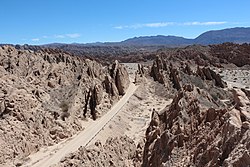Calchaquí Valleys


The Calchaquí Valley (Spanish: Valles Calchaquíes) is an area in the northwestern region of Argentina which crosses the provinces of Catamarca, Tucumán, Jujuy and Salta. It is best known for its contrast of colours and its unique geography that ranges from the mountain desert to the subtropical forest.
There are a number of valleys and rivers within the Calchaquí Valley that have their own name, such as the Quebrada del Toro (Gorge of the Bull), Valle de Lerma (Lerma Valley) near Salta city, the Quebrada de Escoipe formed by the , the Valle Encantado at the feet of the Cuesta del Obispo, the Quebrada de las Conchas of the near Cafayate, the valley of the , and the itself.
These valleys were once inhabited by a number of tribes. Ruins of the Quilmes can be found in Tucumán. Other tribes of the area included the Calchaquíes, Tafí, and the (Santa María). Decades before facing the invasion of the Spanish colonization, the natives of these lands suffered the invasion of the Inca Empire.
Among the most visited tourist attractions of the valley are Tafí del Valle, Cafayate, Molinos, San Carlos, Santa María and Cachi at the western end of the valley, as well as the Los Cardones National Park, and the Los Sosa Provincial Park in Tucumán. In several parts of the valley there are numerous vineyards, specially in the Cafayate area.
The natural reserve Quebrada de las Conchas or also known as Quebrada de Cafayate is located within the Calchaquíes Valleys, in the province of Salta, north of the Argentine Republic, very close to the town of Cafayate.
Located 90 km southwest of the city of Salta, it includes part of the departments of La Viña, Guachipas and Cafayate and belongs to the dry chaco ecoregion and mountain range of saws and pockets. [1] This ravine is an area of great scenic beauty with very striking rock formations for their reddish colorations. In 1995 it was declared by decree No. 6806 as a managed natural reserve, with an area of 25784 ha, in order to protect the curious geological formations and high walls of unique landscape value, as well as an important paleontological site belonging to the period Cretaceous The ravine is a geologically modern accident, produced by tectonic movements that took place in the last two million years.
Through the ravine and within the reserve runs the Conchas River where the trace of National Route 68, which connects the town of Cafayate with the city of Salta. In its route you can see landscapes of very varied colors and geoforms of great variety among which are the Garganta del Diablo and the amphitheater of reddish sedimentary rocks. In the past (when the past was humid) these formations were cascades of fresh water and that by the flow of concentrated water they were eroding the stone, which today astonish by its special configuration.
Other geoforms that can be observed at the edge of the route are. The Amphitheater, The Friar, The Toad, Windows, Castles, etc. and about 7 km from Cafayate Los Médanos, deposit of fine calcareous aeolian sands. [2] [3]
Due to its rich archeological and historical past, the reserve has numerous fossil remains. [4] In the area near the Morales bridge, fossil frogs of the group of pípidos are found. There are layers of marine and continental limestones very rich in fossils and even in dinosaur footprints. Also, the so-called stromatolites are presented. In the Yesera, there is an important fossil fish deposit, evidence of a process that would have occurred some 15 million years ago: the last entry of the sea to the continent.
In recent archaeological investigations it was discovered that a few meters away from the current route 68 the Inca road ran, adding archaeological relevance to the site. [5]
The creek and its surroundings one of the important areas for the conservation of birds in Argentina. [6]
Gallery[]

Quebrada de las Flechas

Quebrada de las conchas

Vineyards in Cafayate

Garganta del Diablo

Cachi overview
See also[]
External links[]
- (in Spanish) Valles Calchaquíes - Salta's Tourist Office
- (in Spanish) Circuito Valles Calchaquíes - Tucumán's Tourist Office
- Valles Calchaquíes Argentine Tourism Board
 Valles Calchaquíes travel guide from Wikivoyage
Valles Calchaquíes travel guide from Wikivoyage- Argentine northwest Archived 2011-05-31 at the Wayback Machine
- (in Spanish) Entre Quilmes y Calchaquíes - Página/12
- Photos of Valles Calchaquíes and Quebrada of Cafayate (English,Spanish,German)
- Los Valles Calchaquíes - Information about places to visit in the Valles Calchaquíes
- Valleys of Argentina
- Tourism in Argentina
- Landforms of Salta Province
- Landforms of Catamarca Province
- Landforms of Tucumán Province
- Tourist attractions in Salta Province
- Tourist attractions in Catamarca Province
- Tourist attractions in Tucumán Province




